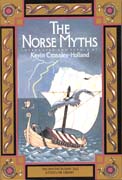 The
Norse Myths
The
Norse Myths
by Kevin Crossley-Holland
A book review by Mark L. Olson
Pantheon Books, 2001, xli+278 pp, $16.00
The Norse myths have been retold countless times and at various levels of sophistication -- even as heavily bowdlerized children's stories. This particular book is an odd hybrid: a scholarly retelling. It scholarly as Crossley-Holland is fully familiar with all surviving Norse literature, reads it in the original, and has provided a large appendix of notes on each of the myths as well as an introduction telling where the myths came from.
Nearly all of them come down to us from Snorri Sturleson, a medieval Icelandic writer of considerable talent who wrote the Prose Edda which tells many of the stories of the pagan religion of Iceland. The Elder Edda is the next best source, consisting of a number of early medieval manuscripts discovered much later. The final major source is Saxo Grammaticus' Gesta Danorum, a mythological history of Denmark.
Very little else exists.
Besides going back to the sources, Crossley-Holland has tried to do a modern prose version of the myths which is both readable to moderns and is true to the original, and he succeeds admirably. Being true to the original is especially difficult with some of the myths which contain valuable information but which appear to be more on the order of lists of kennings than actual stories. (A kenning is a phrase which is a synonym for a proper noun. Norse (and much of Germanic) poetry relined on alliteration and kennings for their effects. Each appearance of a proper noun in a story would use a different kenning. (Examples of kennings for "sea" include "whale-road" and "serpent's lair" (the Midgard Serpent was coiled up under the ocean).) To modern ears this is very strange and confusing; to Old Norse ears it was poetry. I daresay that blank verse would be odd to them and modern poetry would be as boring to them as it is to us.
The stories are fairly gritty -- they're not fairy tales, but more on the order of the old, unexpurgated Grimms'.
It's also worth noting as Crossley-Holland does that the myths are not terribly consistent. While there is a progression from the creation of the worlds to the early days of the gods, to the later days and their wars and finally Ragnarok, many items are not in order ( people are killed in an early myth but present in a later one) and the cosmology and the interrelationships of the Nine Worlds (even the precise identity of the Nine Worlds) is obscure. It's unclear if this is a consequence of the fragmentary nature of the surviving myths or (more likely, I think) the tellers of the myths weren't especially interested in being consistent.
This is undoubtedly the best book of Norse myth I've ever read. Highly recommended.
NESFA homepage | Review Index | More Reviews by Mark L. Olson
